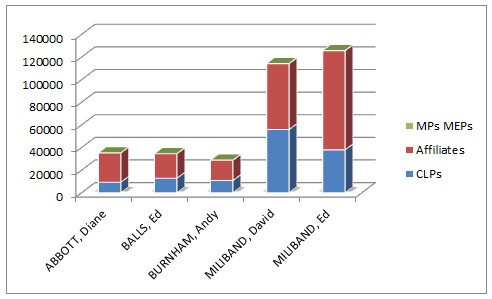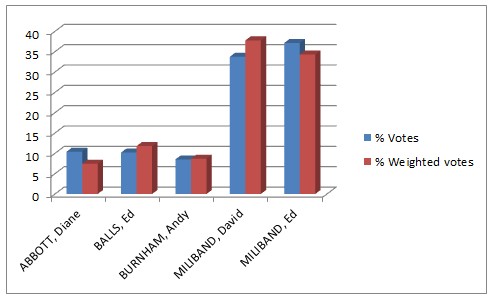I was pleased to see the data behind the leadership ballot released, and also a little surprised. But mostly pleased.
The data is available as a Google Doc here and you can download it all to your own computer to pull it about in Excel. ((or Open Office of course))One reason I was pleased to see it was that it gave me a chance to play with Excel 2010. I installed it the other day, having bought Office 2010 Professional for the bargain price of £8.95 but haven’t had a reason to use it before now.
The reason for my surprise was to do with just how much informatin about the party is contained in it. The spreadsheet effectively gives the membership of every constituency party in the country!  I know the party is gloating a bit about how many extra members have joined this week, but I’m not sure that, say, Banff & Buchan CLP really want it know that their membership is lower than that of Broadfield.
According to the figures, there were 178 ballot papers sent out in Horsham. It might not sound like a lot, but I reckon that when I was selected there were fewer than 150 members so a 20% increase is good to see, especially in a constituency where there has never been an MP or councillor.
A few thougths about the voting and the results, illustrated by charts, because I wanted to play with charts.
There has been a lot of talk about ‘the unions’ winnng it for Ed Miliband. This gives the impression (deliberately? or just conveniently for those in the media with their own agenda?) that there is still the old-fashioned block votes. Of course, as anyone involved should know, the union section of the electoral college is based on one-member-one-vote, which does not blindly follow whateverthe union leaders say anyway. I’m pretty loyal to my union, but still voted for Ed Balls despite their endorsement of Ed M.
The weird thing is that if there is anything remotely resembling a block vote now it is in the MP/MEP section, where each individual’s vote carries as much weight as hundreds or thousands in the other sections.
Anyway. Time for a chart:
This shows the actual votes cast, without any sort of weighting for the three sections. It shows the first preference votes, where Ed M had something like 11,000 more votes than David M in the first round.  Another way of looking at it is in percentage terms:
The blue columns show the results of the first chart with the percentage of actual votes cast. The red columns show how the percentage actually used in the ballot. The difference is mainly because the tiny green slivers in the first chart, which represent the MP/MEP votes actually count as much as the other sections.
None of this proves anything really, just that making charts in Excel is easy and fun. It does show that whichever way you look at it, the race between David and Ed was close. Neither candidate was particularly unpopular in any section of the electoral college. The spreadsheet lists the individual preferences of all the MPs and MEPs so you can see how a lot of them who had Ed 1st had David 2nd and vice versa.
I do think there is something wrong with the way the weighting is done though, and not just because the MP section is worth a third of the vote even with only 266 members. That would not be so bad if it was a secret ballot on their part. I think that must skew the results a lot. Maybe I am being unnecessarily cynical, but if everyone knows how you voted and you might want favours from the new leader, wouldn’t it be tempting to vote for who you think will win rather than who you want to win? (Granted, the two might be the same.)
I will leave it to somebody with more time on their hands than me to work out whether all those who are likely contenders for shadow cabinet positions just happened to vote for the person who looked most likely to win for the last 4 months…
I think that is my main conclusion: the MP section should certainly be a secret ballot and should probably have a reduced significance. Yes, I know all the arguments about how the MPs will know the candidates better and have a more informed opinion, and how they have to work with the leader, but is does that outweigh the principle of democracy?
The other stunning statistic from the mass of numbers is the turnout in the affiliates section: just 9%.  The highest turnout from a union was ASLEF with 25%, but the larger unions all had a turnout of around 10%.
My own union had nearly 950,000 voted not used. Back when there were block votes those votes would have all been cast on our behalf, and not necessarily the way we would have wanted them cast, which was recognised as unfair.
There is a bit of irony in all this.  A union could have ballotted its members and then thrown its whole block behind whoever the most members wanted, even though in a 5-horse race like this it could have been nothing like a majority. Unfair? Certainly, but it is just like first past the post when you think about it, and I suspect that those who objected most loudly about it are those who are the most enthusiastic supporters of FPTP in other areas like general elections.
What occurred to me was that the unions didn’t really win it for Ed, but if they had really put their minds to it all those members could have won it for whoever they wanted to. What is all the 91% or non-voters in that section had all voted for Diane Abbott?
I’m not saying they should have done, but it is a bit like the country as a whole – there is a huge mass of people who have the power to decide who is in charge and they never take advantage of their numbers.





Long tail of the Labour Party | Someday I Will Treat You Good // Sep 30, 2010 at 9:28 am
[…] tail of the Labour Party Posted on 30 September, 2010 by Andrew Brown I’m indebted to Skuds for pointing me in the direction of the detailed breakdown of how we voted in the recent Labour […]